The electron doesn’t have an electric field, it has an electromagnetic field. If you’re a positron and I set you down near a motionless electron, you will move linearly towards it, and it will move linearly towards you. So you might think the electron has a radial electric field, which results in a linear electric force. But it doesn’t. That linear force is there because the electron has an electromagnetic field, and so does the positron.
Linear and rotational force
Moreover the interaction between these fields doesn’t just result in linear force. If you’re a positron and I throw you past that motionless electron, the force between you and the electron is no longer just linear. There’s a rotational magnetic force too. So you might think the electron now has a magnetic field, which results in rotational magnetic force. But it doesn’t. That rotational force is there because the electron has an electromagnetic field, and so does the positron.
You do not create a magnetic field by moving a charged particle
The crucial point to note is that when you’re the positron, I didn’t create a magnetic field for that electron by moving you. I don’t create a magnetic field by moving a charged particle. Because that charged particle always had an electromagnetic field, because it’s a “spinor”, and because spin is real. And because it takes at least two such particles to exert linear and rotational force on each other. An electron is not surrounded by a field of force, or two fields of force. Nor is a positron. Because linear and rotational force is the product of at least two electromagnetic fields interacting. It takes two to tango in the positronium dance of death:
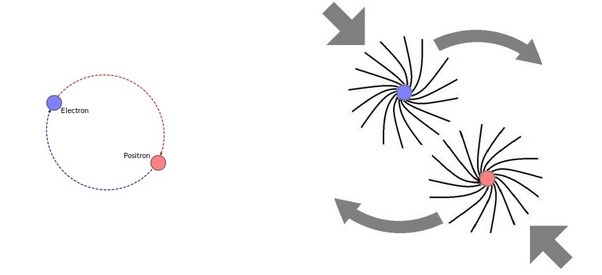 CCASA positronium image by Manticorp/Rubber duck, see Wikipedia, spinor image drawn by me
CCASA positronium image by Manticorp/Rubber duck, see Wikipedia, spinor image drawn by me
Field and force are not the same thing. Force is there when two or more electromagnetic fields are interacting, be it the linear electric force or the rotational magnetic force, or both. When we contrive our charged particles such that the rotational forces cancel, we only see the linear forces, and we talk of an electric field. When we contrive our charged particles such that the linear forces cancel, we only see the rotational forces, and we talk of a magnetic field.
Electric charge is a misnomer
But there are no charged particles where the force is only linear, and there are no charged particles where the force is only rotational. So there are no particles which only have an electric charge, and there are no particles which only have a magnetic charge. The charged particles feel both the linear electric force and the rotational magnetic force. So electric charge is a misnomer. The electron has an electromagnetic field, so it has an electromagnetic charge too.
Electric and magnetic fields exist
That’s not to say there’s no such thing as an electric field or a magnetic field. The region near a thundercloud is not the same as the region near a magnet. An electric field is a place in space where the rotational forces on charged particles cancel, and we only see the linear forces. See the Wikipedia Coulomb’s law article: “an electric field is a vector field that associates to each point in space the Coulomb force experienced by a test charge”. We draw electric field lines between the plates of a capacitor to mark out this linear force. But the force depends on the charged particles involved. An electron will move along the field lines one way, whilst the positron will move the other. Meanwhile a magnetic field is a place in space where the linear forces on charged particles cancel, and we only see the rotational forces. See the Wikipedia magnetic field article: a magnetic field “exerts a force on other nearby moving charges and magnetic dipoles. At any given point, it has a direction and a magnitude (or strength), so it is represented by a vector field”. We draw magnetic field lines between the poles of a magnet to mark out this rotational force. But again the force depends on the charged particles involved. An electron will move around the field lines one way, whilst the positron will move the other.
A field is a state of space
These particles move the way that they do because they are what they are, and because space is what it is. In his 1929 history of field theory Einstein described a field as a state of space. The state of space where the electric field is, is not the same as the state of space where the magnetic field is. They are different, but no so different, just as the positron is not so different to the electron. Because like the Wikipedia electromagnetic radiation says: “the curl operator on one side of these equations results in first-order spatial derivatives of the wave solution, while the time-derivative on the other side of the equations, which gives the other field, is first order in time”. And like Minkowski said, “the division of the field into electric and magnetic forces is a relative one with respect to the time-axis assumed”. As to what the state of space is for electromagnetic fields, there’s a clue in something else Minkowski said.
Space is twisted, space is twisting
Minkowski referred to one field only. He was talking about the electromagnetic field. Note that we didn’t create the electron and positron in gamma-gamma pair production using an electric wave and a magnetic wave. We used electromagnetic waves. The electric aspect of each electromagnetic wave is the spatial derivative of electromagnetic four-potential. The magnetic aspect of each wave is the time derivative of electromagnetic four-potential. It’s like the canoe analogy where the electric field E is denoted by the slope of your canoe, and the magnetic field B is denoted by the rate of change of slope. They are two sides of the same coin, they cannot be separated. This is why Minkowski also said “the two forces considered together can most vividly be described by a certain analogy to the force-screw in mechanics”. When you turn a screw, rotational force is converted into linear force because the screw has a twist. When you work a pump-handled screwdriver, linear force is converted into rotational force because the shaft has a twist. The electron and the positron move like they do because space has a twist. Because the electromagnetic field shares some similarities with the gravitomagnetic field. As you might expect, since Oliver Heaviside developed gravitomagnetism as an analogy of electromagnetism. See the NASA GPB article by Tony Phillips where you can read that space is twisted. Also see the beautiful gravity probe B video by Bob Kahn and James Overduin, animated by Lee Kolb and Greg Trent with music by Ray Lynch:
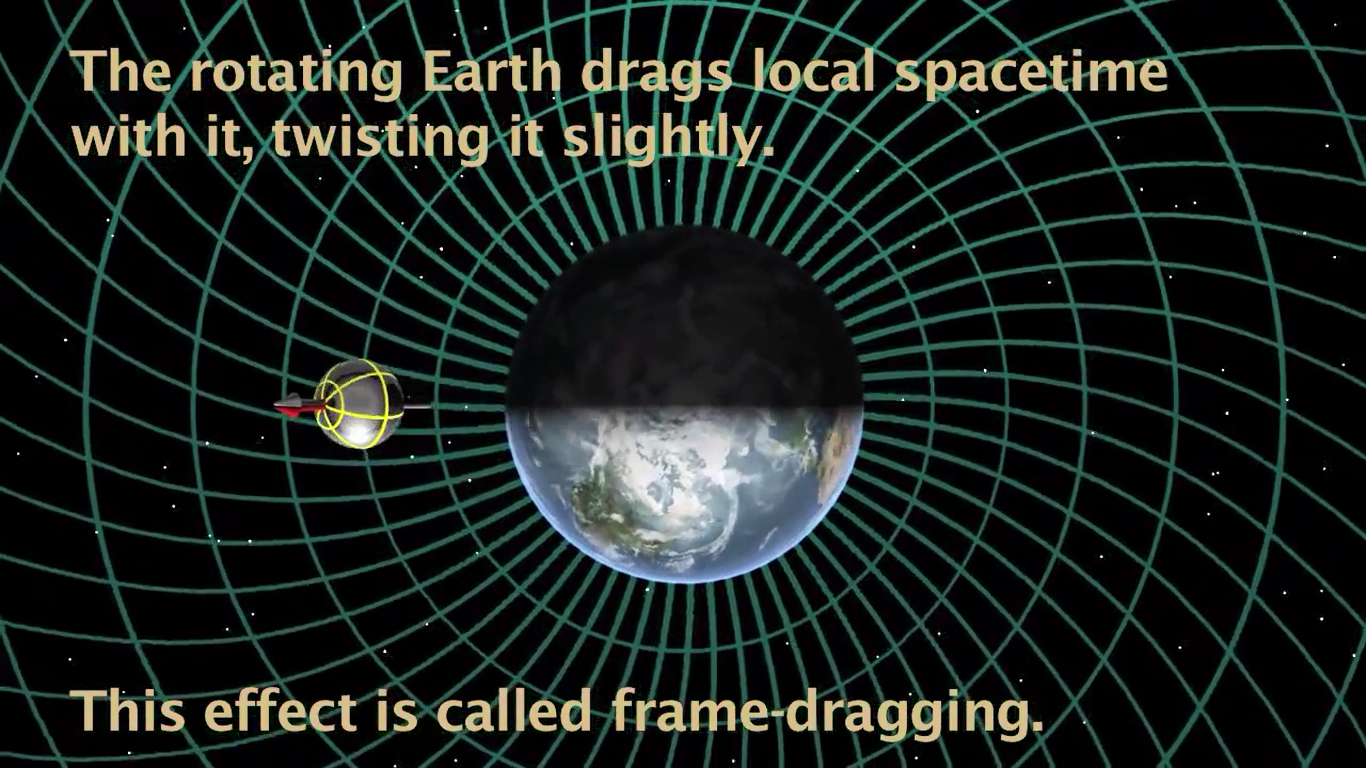 Frame-dragging still image from the gravity probe B video by Bob Kahn, James Overduin, Lee Kolb, and Greg Trent
Frame-dragging still image from the gravity probe B video by Bob Kahn, James Overduin, Lee Kolb, and Greg Trent
I think it’s best to think of the electromagnetic field as a place where space is twisted in a 3D chiral fashion. Then when you think of electrons and positrons it’s easy to visualize that they move the way they do because each is a dynamical “spinor” in frame-dragged space. Each is a spin ½ standing-wave “twist” field with its secret Poynting vector going around and around. Each is situated in the twist field of the other. Each is like a vortex, but they have the opposite chirality, and counter-rotating vortices attract. When the source of this twisted space is moving towards you, it’s like space is twisting. It’s like being in a “turn” field. Hence the screw nature of electromagnetism is all about twist and turn, and so is charge. Because when you throw one vortex past the other they swirl around each other as they attract. The linear and rotational forces are there because of what they are and the space that they’re in. Not because of some magical mysterious action-at-a-distance force. Not because they’re throwing photons back and forth. The only photons you’re going to see are when the electron and the positron annihilate. Then there’s no charge any more. Because charge is not fundamental.
Charge is not fundamental
If you look around on the internet you’ll see plenty of articles saying charge is fundamental. It isn’t. Energy is fundamental. Energy is the one thing you can neither create nor destroy. You can create charge, and you can destroy it, in gamma-gamma pair production and annihilation. And when you’ve created your charged particles you can diffract them, because of the wave nature of matter. You started with photons, with waves that propagate linearly at c. You ended with electrons and positrons, with waves that don’t propagate linearly at c. Instead the electron has its spin, and so does the positron. Like Feynman said, there’s angular momentum in the field. And like the Einstein-de Haas effect says, that angular momentum is of the same nature as the angular momentum of rotating bodies. So something is going around and around. What could it be? Cheese? Magic? Probability? I don’t think so. It think it’s obvious what’s going around and around: light. Or an electromagnetic wave if you wish. Or a pulse of potential if you prefer. Or wavefunction if you will. Only it isn’t so obvious that it’s a wave. Because when the wavelength is just right and it goes around and around just so in a spin ½ twisted fashion, the field variation doesn’t look like a field variation any more.
 Strip images by me, GNUFDL spinor image by Slawkb, see Wikipedia
Strip images by me, GNUFDL spinor image by Slawkb, see Wikipedia
That’s because at all locations around the closed path there’s a superposition of two field variations that add to the same field value. So it looks like a phase-invariant standing field. Hence in atomic orbitals, electrons exist as standing waves. Hence outside of atomic orbitals, electrons still exist as standing waves. That’s all that’s there. There is no billiard-ball at the heart of the whirlpool, and there is no point particle at the heart of the electron. Because the electron’s field is what it is. Because charge is what we call it when an electromagnetic wave goes round and round just so, such that it doesn’t look like a wave any more. Instead it looks like a standing field. Standing wave, standing field. But that isn’t quite enough, because it doesn’t tell you why the wave goes around and around. To know that, you have to know that charge is shiny.
Charge is shiny
There’s a nice little reader-friendly article on charge by Bill Beaty. He’s an electrical engineer at the University of Washington in Seattle. He says this: “Metals look metallic because they contain a ‘fluid’ composed of movable electrons”. You find other articles saying much the same thing. Google on electron metal shiny and take your pick. So when you read Bill Beaty saying “The ‘silvery’ stuff of a metal is the charge” it shouldn’t come as a surprise. However what might, is that you’ve seen something similar on a sunny day. We call it a highway mirage. Light is distorted because the path isn’t straight. The result is shiny. The path isn’t straight after pair production either. Instead the path is curved.
Space waves
When an ocean wave propagates through the sea, the sea waves. When a seismic wave propagates through the ground, the ground waves. And when an electromagnetic wave propagates through space, then surely space waves. There are no waves where something doesn’t wave. And where that something is waving, it is curved. So something else passing through that something will follow a curved path. If that something else is light, its path will curve. When light moves through space where light is, light curves. Then when light moves through itself just right, its path can curve into a closed path. Not because of some magical force. But because like Percy Hammond said: “the field describes the curvature that characterizes the electromagnetic interaction”. And because like Maxwell said, “light consists of transverse undulations”. Maxwell was talking about displacement current. It does what it says on the can. It displaces things. Things like waves in space. Waves in space displace waves in space. Waves interact. Light interacts with light. Not just with matter. If light didn’t interact with light, there wouldn’t be any matter. This is what Schrödinger was talking about on page 26 of quantization as a problem of proper values, part II. He said “let us think of a wave group of the nature described above, which in some way gets into a small closed ‘path’”. Quite.
Light is curved space
Light is a wave in space, so light is curved space. The degree of curvature varies with the wavelength. When you play a guitar the amplitude of your pluck might stay the same, but the curvature of the string is greater when the note is higher. I think the photon is something similar, with Planck’s constant h corresponding to your pluck. Then when you play a very high note, when the wavelength is 2π times the amplitude, a wave of spatial distortion can interact with a similar wave and curve such that it ends up moving through itself. Then its path keeps on curving, and light ends up doing what a hedgehog does: it curls up into a ball.
Charge is all-round spatial curvature
That’s when we call it charge. An electromagnetic wave consists of a positive field variation followed by a negative field variation. Field is the derivative of potential, so you can draw a sine wave to represent the electromagnetic wave, then you can draw the potential as a sinusoidal hump. The hump is highest in the centre where the sine wave goes from positive to negative. The electromagnetic field there is zero, but the potential is at a maximum:
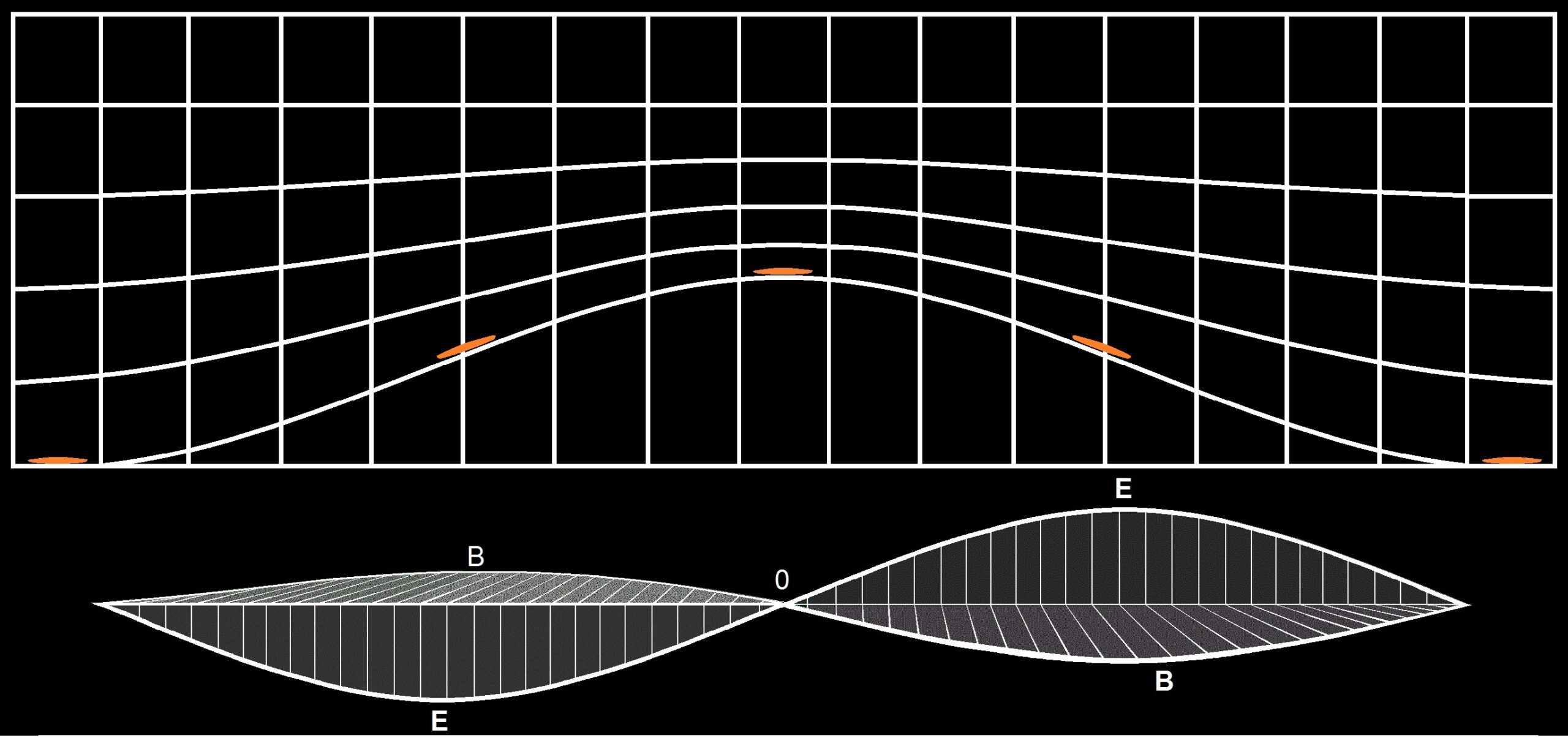
When you twist it round and wrap it up in a spin ½ configuration, it’s like making a Möbius strip. The positive field variation is rotated into negative field variation, then two negative field variations combine to create an all-round negative standing field. Alternatively when you twist it round the other way the negative field variation is rotated into a positive field variation, then two positive field variations combine to create an all-round positive standing field. The two alternatives have the opposite chirality:

You now have a spinor of sorts. However space is not a flat strip. Instead the electron is spherically symmetric, and so is the positron. To visualize this you have to inflate the strip into a ring torus, then a horn torus, then a spindle-sphere torus. The result isn’t a spinning ball of charge. It’s a bispinning wave of light, with a spherical centre like the eye of the storm. Only it looks like there’s no phase change, so you can’t see that it’s spinning:
 Torii courtesy of Adrian Rossiter’s torus animations
Torii courtesy of Adrian Rossiter’s torus animations
Now you have an all-round spatial curvature. The strong curvature regime isn’t where a black hole is, it’s where the electron is. This curvature diminishes with distance from the centre because the electron’s field is what it is. It’s a charged particle, with a charge of 1.60217662 × 10-19 Coulombs. That’s “unit” charge, and it’s unit charge for a reason.
Unit charge
An electron is a charged particle, an all-round standing wave where an all-round spatial curvature. This charged particle has unit charge, because charge is topological. To really understand this, draw an all-round circle. 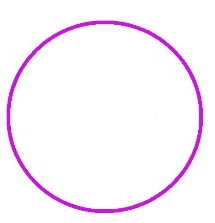
Imagine what would happen if I performed a Compton scatter on this thing. The frequency of the incident photon is reduced and the electron moves. It’s as if I peeled a slice off that incident photon and slapped it onto the electron. This electron has a Compton frequency because it is in essence a 511keV photon. It’s in a spin ½ configuration, but you can still diffract it, because it’s still a photon at heart. When you combine two photons into one you increase the frequency. So we have increased the frequency of our electron. And because the degree of curvature is related to frequency, we have increased the curvature. Imagine you had to increase the curvature of a circular piece of wire. It’s very difficult to compress the wire all round into a smaller circle. But it’s very easy to increase the curvature if the wire has two free ends that can slide past one another. You could increase the curvature like this: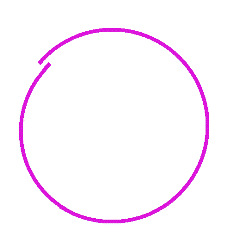
Now it’s more than a circle. There’s more than 360° of curvature. Now we have more than unit charge. But remember the electron is a dynamical spinor, so draw another circle on the end of the first. Then another and another. Now what you see, is that if the circle is more than a circle, if the curvature is more than 360°, if we have more than unit charge, the electron moves:
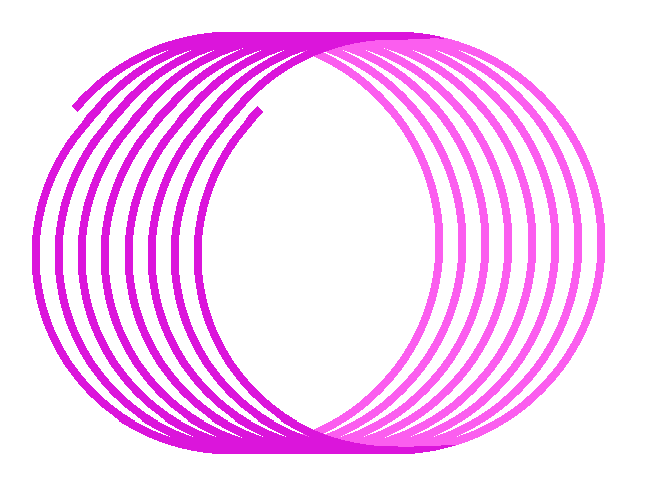
Throw a photon at a free electron and the electron is still a standing wave, but it isn’t standing still any more. You might be, but when you chase it and catch it up and measure the charge, what you measure is unit charge. Because in your frame, the electron path is circular again.
What charge is
Like I was saying an electromagnetic wave is a wave in space, a place where space waves, and so a place where space is curved. Like William Kingdon Clifford said in his space theory of matter, nothing else takes place. Gamma-gamma pair production is merely what we call it when two such waves each displaces the path of the other into itself, whereupon each wave displaces its own path into a closed chiral path. Then each sinusoidal field variation is configured as an all-round standing field, and we apply the label charge. So a charged particle like the electron is a spindle-sphere electromagnetic wave in a standing-wave spin ½ spinor configuration, and charge is a place in space with an all-round spatial curvature that goes full circle. This curvature reduces with distance akin to frame-dragging, and since there are no circles of more than 360°, we have unit charge. We talk of positive charge and negative charge, but the positron is a place where space is curved just as much as the electron, just as your left-over-right shoelace is curved just as much as your right-over-left. There is no negative curvature, there are no sources and sinks, there are no magnetic monopoles, there are no virtual particles popping in and out of existence, spontaneously, like worms from mud. Light interacts with light, there are no point particles, spin is real. The electron field is just a trivial-knot disposition of the photon field, the photon is more fundamental than the field it’s supposed to mediate, and charge is topological. All in all there are some issues looming for particle physics. Particularly when you realise that we’ve never ever seen a particle with color charge. All the more so when you appreciate that all charged particles have mass.
Hi John,
A lot of this sits well with me especially “if the curvature is more than 360°, if we have more than unit charge, the electron moves”, I like this idea very much. What I’m a bit confused about though is if we are to think of the electric charge of an electron as a twisting of space, the trouble is that there is always an orientation to a twist, or put another way, the spindle-sphere you talk about has a spindle and ‘north’ and ‘south’ pole – which would mean you could turn an electron upside down to get a positron, surely?
Thanks!
Jonathan: no, because of the double rotation. The spindle sphere torus is just a fat torus. So fat that it looks like a sphere. But it isn’t a sphere. Look at the torus animation in https://physicsdetective.com/the-positron/. You can’t convert one to the other by turning it upside down, just as you can’t reverse the chirality of a Möbius strip by turning it upside down.
.
Another way to think about it is to use a glass clock. The hands go round clockwise, twisting space as they do, via something akin to frame dragging. But walk round the back of the glass clock, and now the hands look like they’re going round anticlockwise. Now spin the glass clock like a coin. Which way are the hands going round now? Clockwise, anticlockwise, clockwise, anticlockwise? It’s hard to say, isn’t it? But you can spin another glass clock with your other hand, and what’s then easy to say is that the two spinning glass clocks each have a compound spin, and the two compound spins are opposite to one another.
This link is broken – https://staff.fnwi.uva.nl/m.renzo/materials/WhatIsSpin.pdf
I’m enjoying these essays, thank you.
My pleasure Alex.
.
Sigh, the dreaded link rot. I’ve found another source of Hans Ohanian’s “What is spin?” paper and amended the URL to this:
.
https://www.physics.mcmaster.ca/phys3mm3/notes/whatisspin.pdf
.
Here’s another one:
.
https://sci-hub.st/10.1119/1.14580
.
Sadly I link to Hans Ohanian’s paper in fifteen articles. I’ll fix the rest later. Note that Sci-hub gets chased around whack-a-mole style, so a large number of links get broken repeatedly. If you click on a paper with Sci-hub in the URL, change the domain extension from tw to st.
lol if students use a calculator to compute 8 / 2 than they may as well compute 8.34. / 1.95 !,,!,,
The important point, Steve, is that if students know what charge is, if they know that the electron’s electromagnetic field is just a wrapped-up field variation that looks like a standing field, they then will appreciate that color charge is misguided. It’s similar if they then know that electron mass is a measure of resistance to change-in-motion for a wave in a closed path. Then they know that the Higgs mechanism is misguided too. Then they know that the Standard Model has one or two… issues. I should write about it I suppose.
John Duffield aka “Farsight” wrote above :
.
” There are no particles which only have an electric charge, and there are no particles which only have a magnetic charge. The charged particles feel both the linear electric force and the rotational magnetic force. So electric charge is a misnomer. The electron has an electromagnetic field, so it has an electromagnetic charge too. That’s not to say there’s no such thing as an electric field or a magnetic field.”
.
Dear John, I do assume that you must be completely correct in your above assertions.
.
First, let me tell you what I have learned at school, and then you will tell me what is wrong with my mainstream understanding, OK ?
.
And so the mainstream story goes. According to quantum mechanics, electric energy is quantized, and electrically charged subatomic particles are carriers of elementary electric charges. For example, electron and muon, even though have different masses, carry the same elementary negative electric charge.
.
Elementary electric charges only exist as one of properties of subatomic particles. Properties of an electron are: mass, spin, and elementary negative electric charge.
.
Because elementary electric charges only exist as one of properties of subatomic particles, we can separate electric charges by separating particles.
.
A separate charged subatomic particle, like electron, muon, or proton, always have an associated magnetic field (N,S).
.
So far, the existence of elementary magnetic monopoles has not been experimentally observed.
.
We may ask a composite question:
1. Is a spinning electron the cause of its magnetic field?
2. Is magnetic field of electron the cause of its property of elementary negative electric charge?
3. Or, perhaps both, electron’s charge and electron’s magnetic field always co-exist as the inseparable phenomenon of elementary electromagnetism?
.
Elementary magnetic N-S field of electron can’t be the cause of its elementary negative electric charge, because for a proton, its elementary magnetic N-S field is the cause of its elementary positive electric charge. Therefore it only make sense that it is the spin of a particle carrying an elementary electric charge that always result in a full N-S magnetic field.
.
The reason that the above option 3. is not possible is that each field would need to have it own independent source. While electric field of electron emanates from its electric charge, what is the source of magnetic field?
Clearly, magnetic poles are not particles that could be separated. Therefore the source of electric field is an electric charge, and the “source” of magnetic field is spin of electric charge. These two fields always exist together, and the reason that they are not one and the same field is that each field has its own separate source.
.
The electric charge is more fundamental (a cause) than magnetic field, because there are no magnetic monopoles, and magnetic field (N-S) can’t generate an electric monopole.
.
Now, I must say that there is no such thing as an electromagnetic field or electromagnetic charge.
.
There is only an electromagnetic wave.
.
There is no such thing as the rotational magnetic force, because magnetic field is static (magneto-static) and it has been demonstrated by simple experiments. Electric field is also static (electro-static), but spinning of the electric charge generates only magneto-static field. All of it was experimentally verified.
.
John, you correctly said :
.
” That’s not to say there’s no such thing as an electric field or a magnetic field.”
.
Yes, and any field of energy has to have its source. For electric field it is the electric charge, and for magnetic field it is the spin of electric charge. Therefore there are no magnetic monopoles possible. and the reason why there can’t be such thing as an electromagnetic field is that had it existed, it would have had its single source, and there is no single source of electric and magnetic field. So, all we can have is an electromagnetic wave, which is a disturbance in an electric field only.
Dear John, now please tell me what is wrong with my above understanding.
Thank you very much.
Ziggy
Dear John, in the following comment to your other post, “The screw nature of electromagnetism”, I finally proved how there is no such thing as an electromagnetic field, but only an electromagnetic wave :
.
https://physicsdetective.com/the-screw-nature-of-electromagnetism/#comment-6045
.
.
I’d agree with that, Zbig. IMHO the electromagnetic field is merely what you get when you wrap up an electromagnetic wave such that the minima and maxima combine. As in the third picture on this article. The photon is more fundamental than the field it’s supposed to mediate.
.
I see you’ve left a lot of comments. Sorry I haven’t answered them yet. I have been flat out with other matters in the last few days.
John — ” the electromagnetic field is merely what you get when you wrap up an electromagnetic wave such that the minima and maxima combine.”
.
Sure, now it is clear and acceptable to me.
.
John, the only point I was trying to make was that the mainstream physics is very sensitive to proper terminology. I know that it is convenient to make terminological short-cuts, but if at the end of the day it does not refer to anything correct, then we are talking pseudo-scientific mumbo-jumbo, or quantum meta-physics. :-))
.
John, please, click here :
.
https://physicsdetective.com/how-pair-production-works/#comment-6064
.
How do you reconcile waves going around and around because other waves curve space with the superposition principle?
Sandra: take a look at https://physicsdetective.com/how-pair-production-works/. When an ocean wave rides over another ocean wave, it changes direction as it goes up the other wave, and changes direction again as it goes down the other side. It also was in superposition as it did this. I envisage that it’s somewhat similar for waves in space.
So, if I turn a electron right-handed upside down it will become a left-handed positron ?
No. It’s chiral. Like the knots in your shoelaces. You can’t convert a left-over right knot into a right over left knot.
How wide is a photon ? Perpendicular to direction of propagation.
As far as I know it doesn’t have a width in the usual sense. I think of it as something like a seismic wave in space. A seismic wave in the ground might move your fridge northwards by 1 metre, then back again. But the seismic wave isn’t 1 metre wide. I might be 10km North of you and I notice that my fridge moves half a metre northwards, then back again. Somebody else might be 100km North of you, and maybe his fridge moves 10cm northwards then back again. You could continue this until the wave is swamped by other stuff.
Hello, thank you for your work here. “Space is twisted, space is twisting” – you mean ether is twisted, ether is twisting?
Tony: yes. Einstein talked of a field as a “state of space”, and said “space is the ether of general relativity”. Contemporary authors such as Baldomir and Hammond have talked about electromagnetic curvature, and you can read about twisted space in the context of gravitomagnetism. Unfortunately twisted space in the context of electromagnetism doesn’t seem to feature in the physics media. I find that surprising, because Heaviside based gravitomagnetism on electromagnetism.